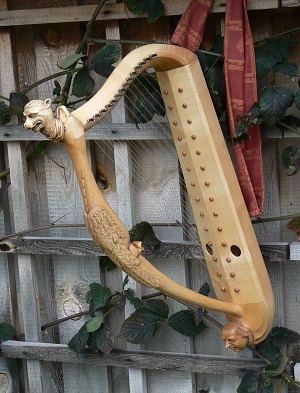This is the oldest form of harp in Europe.
The instruments are reconstructed mainly following illustrations in early Christian manuscripts, the psalters.
Romanesque harp, St. Blaise's Abbey

An illustration in a manuscript from St. Blaise's Abbey in the Black Forest was the inspiration for this harp. I build this harp with romanesque decor in the spirit of the period 800 - 1100 A.D.
- Wood: Maple
- Height: 69 cm
- Strings: 18 in gut
- Range: a-d'''
- Weight: 1.4 kg
Double-strung harp, Spain, around 1390
 This interesting harp is illustrated on a triptych in Piedra monastery in Spain.
This interesting harp is illustrated on a triptych in Piedra monastery in Spain.
I make this harp after the iconographical depiction, with parallel rows of 16 strings each. The double stringing can also be tuned chromatically, if the player wishes. This means that this model offers many opportunities for experimentation in early music.
The carving on this instrument has not been identified yet but may depict a legend of the period.
- Wood: Maple
- Height: 74 cm
- Strings: 2 x 16 strings in gut
- Range: d-e'''
- Weight: 3,9 kg
Hunterian Psalter Harp
 Romanesque harp, England, 12th century
Romanesque harp, England, 12th century
This shapely Romanesque harp is based on the so-called Hunterian Psalter. The harp has a bright, clear tone. I also make this harp with the original decoration on the neck and pillar: Further information can be given on request.
- Wood: Maple
- Weight: 79 cm
- Strings: 19 / 21 in gut or fluorocarbon
- Range: g-d''' / g-f'''
- Weight: 1.8 kg
A double-strung diatonic version of this harp is also available
Sequentia, Hanna Marti - Song of Consolation by Boethius
